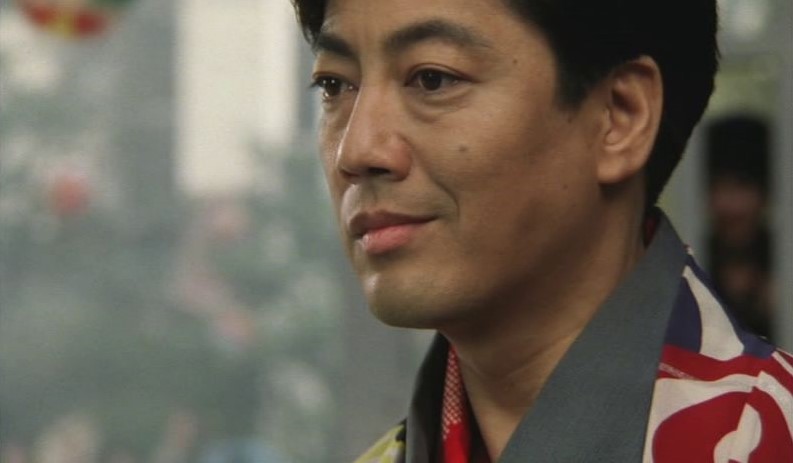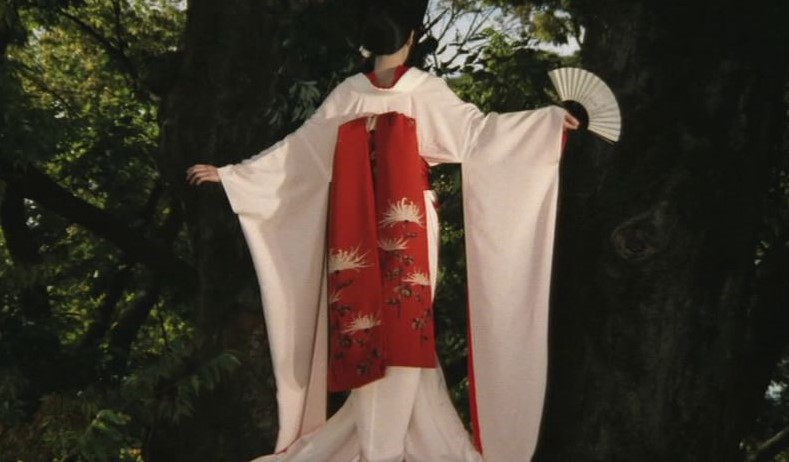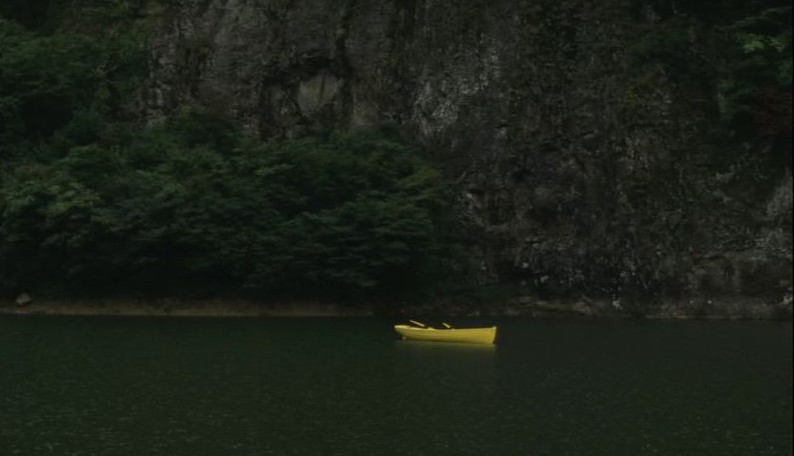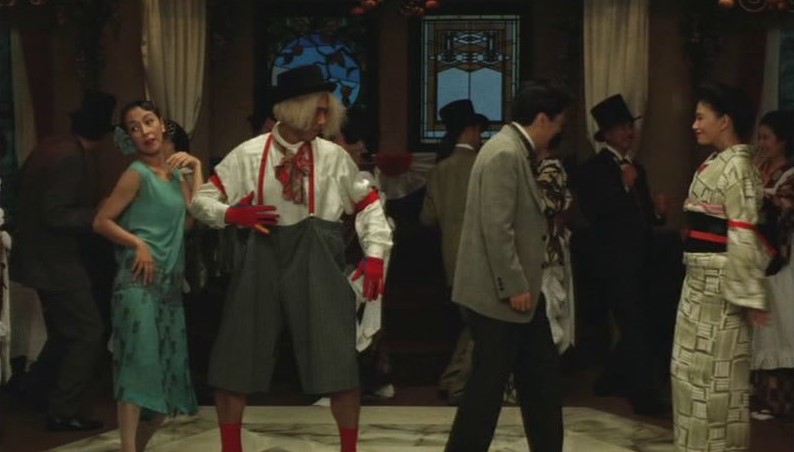Seijun Suzuki’s Yumeji (Japan, 1991) is the concluding part of his “Taisho Trilogy”, the two other films being Zigeunerweisen (Tsigoineruwaizen, 1980) and Kagero-za (1981). All three are set in the Taisho era (1912-1926), a period in Japanese history marked by attempts to achieve more democracy – both political and cultural. The protagonists in Zigeunerweisen are a university professor, a brutish drifter and a geisha, who form a bizarre love triangle. In Kagero-za, a playwright is attracted to a woman who is perhaps the ghost of his former patron’s wife. The third film, Yumeji, has its focus on a historical figure, namely the poet and painter Yumeji Takehisa (1884-1934), famous for his illustrations of beautiful women on book covers, in newspapers, on postcards, etc. His paintings and drawings of women with large eyes had some influence on the shojo manga genre (“girls’ comics”), which targets a readership of female adolescents and young women.

Yumeji Takehisa was also a notorious womanizer. Two of his models, both of whom he had affairs with, figure as principal characters in the film – Hikono Kasai, who died of tuberculosis in 1919, and Oyo, with whom Yumeji Takehisa lived in the early 1920s. There is also a brief reference in the film to Yumeji’s implication in the High Treason Incident in 1910, a plot to assassinate Emperor Meiji, following which the artist was arrested but then released after two days of interrogation. However, Suzuki’s film is by no means a biopic but rather a fantasy film in which the boundary between reality and dream is constantly blurred.
The film starts with Yumeji (Kenji Sawada) reaching out vainly for a female figure who appears above him and in a tree. The woman turns her back to him, thereby preventing him from seeing her face. As in the two other parts of the “Taisho Trilogy”, Yumeji deals with the relationship between men and women and with pictures of women in the minds of men. Its protagonist is depicted as an artist driven by the desire to capture female beauty in his paintings and drawings.

The film’s narrative consists of a series of episodes in which the only constant factor linking them is the character Yumeji. His main motivation as a painter – the quest for female beauty – runs through the film as a leitmotif.
Yumeji’s lifestyle, with its emphasis on his art and the strong desire to paint the women he is attracted to, can best be described as egocentric. This aspect is underlined by Yumeji’s behaviour, by his sometimes clownish facial expression and by his emotional outbursts, indications of both his bohemian lifestyle and the immature side of his personality. For example, he is shown wearing a colourful cap like those commonly worn by young children in the West and in Japan. In one sequence, he crosses open countryside with jumping movements; in others he walks like a robot. Kenji Sawada, a rock star and actor, plays the character with a mixture of naturalism and theatricality, displaying moments of deep reflection as well as others that are close to hysteria.
The film’s elaborate aesthetics are appropriate to Yumeji’s extravagant sexual fantasies, which feature, among other things, naked or half-naked bodies and in which sexual intercourse is suggested rather than represented. The stylization, the abundance of cinematic devices and the disrupted narrative reflect the protagonist’s hedonistic lifestyle, with double exposures, bird’s-eye views, slow motion and freeze frames employed as means to destroy the illusion of realism. As well as shots of Japanese-style rooms dominated by beige, white and brown, there are others in which stark primary colours heighten the feeling of artificiality. The geisha house is swathed in an intense red light; the boat floating on the lake is painted bright yellow; and one long dialogue sequence takes place against a royal blue background.

Suzuki creates whole series of beautifully composed shots that are framed like paintings. These static images match the film’s slow rhythm and contribute to the overwhelming feeling of artificiality. This slow rhythm is, however, disrupted by sudden movements, for example when the small rowing boat moves at great speed as if driven by some invisible force. At one point, it even abruptly assumes a vertical position in the middle of the lake. When Yumeji’s hand touches a wooden post at a railway station, it leaves not a fingerprint or a mark but the beautiful sketch of a woman, a sketch clearly inspired by the work of the real-life Yumeji. Other sketches of women appear almost miraculously on the outside of the rowing boat. There are, however, also elements of the fantastic that are closer to horror and the grotesque than to eroticism. In one scene, women are preparing radishes for a meal, and among them is a human leg, which they treat just like the radishes, cleaning it as if the difference has gone unnoticed. In the next shot, a human figure emerges from a pan of thick soup bubbling on the stove.
The exuberant aesthetics contribute to the film’s dreamlike nature. However, the dream of beauty is repeatedly challenged, beginning in the opening scene, when Yumeji’s desperate attempt to see the face of the woman in the tree is thwarted by the appearance of a mysterious figure with a gun who shoots at him. Much later, the identity of this man is revealed as Sokichi Wakiya (Yoshio Harada), the husband of one of the women Yumeji falls for and a man who is presumed to be dead. Wakiya is dressed like the recurring image in the film of a doll dressed as a clown, and he also has the same fair hair as this doll. And just like this small clown figure, he is a disturbing presence. The murderer called “Devil Matsu” (played by filmmaker Kazuhiro Hasegawa), who is armed with a scythe and haunts the neighbourhood, presents a similar threat to Yumeji’s way of life. Suzuki gives no clue whether these two men who hinder Yumeji in his quest to capture female beauty are dead or alive, whether they are perhaps ghosts or projections in the protagonist’s mind. Or, in the case of Matsu, a projection in the mind of the policeman who failed to arrest him.

The Eros-Thanatos opposition forms the essential link between the three parts of the trilogy. Right from the beginning of Yumeji, a connection is established between eroticism and death. In the opening sequence, Yumeji thinks that Wakiya – at this point a figure of unknown identity whose face is not revealed – has shot him in the head. Later, Wakiya expresses his desire to kill Yumeji and challenges him to a duel, and the killer Matsu asks Yumeji to assist him to commit suicide.
Various visual motifs signal the presence of death, for example the gun that is frequently shown. The other important motif is blood. According to his wife, Wakiya has been thrown by the jealous Matsu into the waste pipe through which the blood of the animals in the abattoir drains into the lake, and he emerges from the water, his naked body covered in blood. This abattoir in the neighbourhood of the Wakiya mansion is mentioned numerous times, and in the sequence that takes place in the geisha house, the head of a cow is displayed as part of a tasteful arrangement of food on a tray. The colour red that dominates the surrounding space in this sequence evokes the symbolic closeness between sexuality and death. Other allusions to death include ravens, a human skull, a heap of bones covered with blood outside the abattoir and pampas grass – in Japanese culture a symbol of the transitoriness of life.
Wakiya accuses Yumeji of leading a superficial and egocentric life. And Yumeji asks himself: “Who am I waiting for? What am I waiting for?” However, Suzuki avoids any moral judgement; moreover, decadence is not used as the basis for a critical depiction of the Taisho era or, by extension, of present-day society. Instead, the director points to the discrepancy between his idealized vision of life and reality. The film’s central notion of beauty is repeatedly threatened, with the painter-poet unable to control his dreams and fantasies. Yumeji is an approach to one man’s obsession, emphasizing the fragility of a human desire that remains unfulfilled.